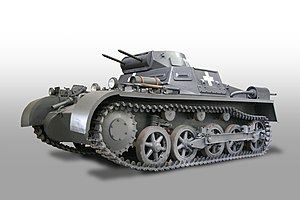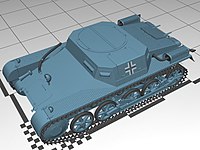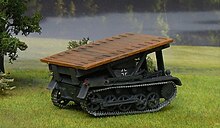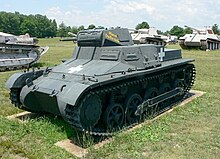Panzerkampfwagen I
| Panzerkampfwagen I (Ausf. A) | |
|---|---|

Panzer I (Ausf. A) |
|
| General properties | |
| crew | 2 (commander, driver) |
| length | 4.02 m |
| width | 2.06 m |
| height | 1.72 m |
| Dimensions | 5.4 t |
| Armor and armament | |
| Armor | 6 to max. 13 mm |
| Main armament | 2 × MG 13 (7.92 mm ammunition: 1525 rounds) |
| agility | |
| drive |
Four - cylinder boxer engine type Krupp M 305 (57 HP) |
| Top speed | 37 km / h |
| Power / weight | 10.6 hp / t |
| Range | 100/140 km (terrain / road) |
The Panzerkampfwagen I (also PzKpfw I or Panzer I ; listed in the Wehrmacht as Sd.Kfz. 101 ) was a German light tank from the 1930s and the early years of the Second World War . It was the first German armored vehicle to be mass-produced after the First World War . Between 1934 and 1937 almost 1,500 vehicles were built, whereby there were several further developments and variants in addition to the main versions "A" and "B". Originally designed as a pure training tank, the tank was nevertheless used in combat. Due to its low combat strength, however, it was largely retired as a combat vehicle by the end of 1941. The remaining vehicles were rebuilt many times and continue z. B. used as a carrier for anti-aircraft or anti-tank guns.
history
requirement
The Versailles Treaty forbade Germany to build or own a tank weapon. To circumvent these regulations, the Reichswehr leadership used the support of the Red Army between 1927 and 1933 . Secret tests with so-called light and large tractors as well as training courses for the associated cadre personnel took place in the Kama tank school near Kazan .
The tests with the previous "tractors" in the early 1930s showed the military leadership that new paths had to be broken in order to provide the troops with fully fledged armored vehicles. Since it was foreseeable that the Panzer III and IV tanks , which would not be available until later - but their design features had already been determined - would not be available quickly enough after obtaining military sovereignty, the decision was made to obtain a useful training aid.
development
In 1933 the Heereswaffenamt (WaPrüf 6) published a tender for the development of an armored car of the 5-ton class, which was to be equipped with two machine guns in a pivoting turret and to withstand fire from infantry weapons. The following companies took part in the tender:
- Croup , food
- Daimler-Benz , Berlin-Marienfelde plant
- Henschel & Sohn , Kassel
- MAN , Nuremberg plant
- Rheinmetall , Düsseldorf
After a detailed examination, the Army Weapons Office awarded the Krupp type "LKA I" the contract and commissioned the Krupp company with the development and construction of the chassis and gearboxes; the superstructure and tower were manufactured at Daimler-Benz.
The Henschel company, which was actually involved in the replication, produced the first three prototypes, which were delivered in December 1933 and tested in the spring of 1934 in the test center for motor vehicles (Verskraft). The first 15 models were delivered with an open hull and without a tower, which is why they were mainly used as driving school vehicles.
Even then, some vehicles were equipped with the air-cooled Krupp M601 diesel engine, but the output of 45 HP was considered insufficient and the tests were not continued. Thus, practically until the diesel engine of the Tatra 111, which appeared in 1942, no further development attempts were made to create air-cooled diesel engines for armored vehicles.
The internal project name (LKA / LKB) was replaced over time in favor of the camouflage designation "Agricultural tractor (LaS)". In 1938 the name was changed to "Panzerkampfwagen (MG) (SdKfz 101) I Ausf. A" due to the military device names that were now used. The tank was presented to the public for the first time in September 1935 in Nuremberg at the Nazi Party Congress.
The troop test soon showed that the air-cooled 57 HP boxer engine from Krupp was too weak, so that the more powerful " Ausf. B " was built. The biggest difference was in the use of the new water-cooled six-cylinder in-line engine from Maybach with 100 hp. Due to the larger engine, the engine compartment and the armored hull were lengthened, which in turn made an additional pair of rollers necessary. Despite the increase in the combat weight to 6 t, an increase in the maximum speed and an improvement in the power to weight ratio was achieved. The tank remained otherwise unchanged except for the installation of an improved gearbox.
production
In addition to the two main development companies Krupp and Daimler-Benz, the companies Henschel, MAN and Wegmann (from 1935) were used for the replica. Series production started in July 1934 with 150 vehicles at Henschel. The exact number of “Ausf. A ”fluctuates between 477 and 818, the latter number seems appropriate in that, together with 675“ Ausf. B “the undisputed total of 1493 Panzerkampfwagen I is reached. The production figures, which include not only combat vehicles, but also makeshift or training vehicles, are as follows:
- 1934: 54
- 1935: 851
- 1936: 557
- 1937: 31
use


With the PzKpfWg I in August 1935, the idea of a large operational tank unit was demonstrated as part of test exercises in the Munster-Soltau area . The success of these exercises confirmed the concept of the armored division and the planned formation of three armored divisions by October 1935.
The PzKpfW I received its baptism of fire in the Spanish Civil War , in which German tank units took part from autumn 1936 under the command of Colonel Ritter von Thoma . At the zenith of this war, around 120 PzKpfW IA and B were probably in use, divided into four divisions, each with three companies of 15 tanks each. The tanks had only a limited combat performance due to their inadequate armament and weak armor and were literally outclassed by the Soviet-made T-26 tank of the Republicans. As a result, six Panzer I were equipped with the Italian 20 mm L / 65 Breda flak model 1935 in early 1937. As the Condor Legion was dissolved after its return to Germany, these vehicles would appear very unlikely to be used in World War II.
When Austria was annexed, the tanks were not involved in combat activities, but had to travel a longer distance. On the sometimes more than 600 kilometers, some tanks broke down due to breakdowns, which sparked a controversial debate and led to a complete reorientation of the repair and recovery services.
The PzKpfW I was never designed as a battle tank in the true sense and was primarily used as a drill tank and for training in tank driving schools. However, German industry did not succeed in producing enough new tanks to replace the PzKpfW I with the newly developed and more powerful Panzer III and Panzer IV as planned before 1939 . In the early days of the war, it was immediately apparent that neither the firepower nor the armor enabled these cars to fight against enemy armored vehicles. At the beginning of the Second World War , the armament of the army amounted to around 1,450 combat vehicles. During the French campaign there were 1077 vehicles, of which only 523 were in the attacking divisions. In 1941 the Panzer I was finally retired. The total losses including the modifications up to April 1942 amounted to a total of 853 tanks, of which the total losses in the first three years of the war can be quantified as follows:
- 1939: 89 pieces
- 1940: 232 pieces
- 1941: 415 pieces
Versions
Further development
Although the low combat strength was already evident before the war, on September 15, 1939, the Army Weapons Office was asked to further develop the PzKpfW I. A light and at the same time fast vehicle for reconnaissance purposes and for the airborne troops was required, which should be equipped with a 20 mm automatic cannon. Krauss-Maffei AG was involved as development company for the chassis and Daimler-Benz AG for the tower. A total of 40 vehicles of the “Ausf. C “(VK 601) and delivered from mid-1942.
On December 22, 1939, another development order was placed with the HWA. The list of demands provided for a combat vehicle with the focus on stronger armor for immediate infantry support. The result was the “Ausf. F ”(VK 1801), which was built to be more robust due to its high weight of 20 t and like the“ Ausf. C ”had offset rollers. It had the same engine as the Maybach HL 45P, but the top speed was reduced to 25 km / h and the range to 150 km. The unusually strong front armor was 80 mm. The pilot series of 30 pieces was delivered by Krauss-Maffei from mid-1942 ; however, the follow-up order for 100 pieces was withdrawn. For the first time, the test installation of radio devices with on-board communication was successfully carried out in this version. Although two of these vehicles were used for assessment purposes during the war against the Soviet Union , there is no evidence that this version was ever issued to the Wehrmacht. At least ten vehicles, however, were used by the Ordnungspolizei, one of which was exhibited at the Aberdeen Proving Ground in the USA in 1946 after it had previously been used in the 2nd Police Tank Company.
variants
Small tank command car
As early as 1936 and 1938, considerations were made of making armored command vehicles available to the tank units. This idea ultimately led to the “Small Panzer Command Car” (Sd.Kfz. 265). The development and manufacture of this mainly on the “Ausf. B “based command vehicle was the responsibility of the Daimler-Benz company in Berlin-Marienfelde. Instead of the regular tower, the PzBefWg had a fixed structure that offered space for a radio operator, a chart table and an additional radio device (FuG 6; range of 10 km for voice and 13 km for Morse reception). A MG 34 in a spherical shield with 900 rounds of ammunition was available for close defense . In total there were three different types “1 kl. B "," 2 kl. B "and" 3 kl. B ”, which differed only insignificantly. Of the model that was in service until the end of 1942, 184 vehicles were built: 25 vehicles of the first series were based on the A version, the 47 vehicles of the second series and the 112 vehicles of the third series were based on the B.
PzKpfW I (A) ammunition tractor
A whole series of other variants were created on the basis of the basic version. The chassis of the “Ausf. A “as a template for an ammunition tug that should follow the armored troops and enable supplies deep into enemy territory. The Daimler-Benz company in Berlin-Marienfelde produced 51 vehicles, which were officially designated as "PzKpfW I (A) Munitionsschlepper" (SdKfz 111). The unarmed supply vehicle had a total height of only 1.40 m and a crew of two men. Two hinged steel plates were mounted on the turntable of the distant tower, through which one had access to the ammunition room. The armor was 15 mm at the front and 13 mm at the sides. Due to a modification of the fuel tank, the range was reduced to about 95 km. There was no radio equipment.
Panzerjäger I
As early as 1939, the Alkett company in Berlin-Spandau produced the first so-called tank destroyers, which were to point the way for the impending development of self-propelled guns. Here the “Ausf. B ” a Czech 4.7 cm anti-tank gun was attached due to the lack of German anti-tank guns . The structure was open at the back and at the top; front and side there were 14.5 mm thick protective shields. The official designation of the "Panzerjäger I" was "4.7 cm Pak (t) (Sfl) auf PzKpfW I, Ausf. B". With a total height of 2.25 m with a three-man crew and 86 rounds of ammunition carried, the combat weight was 6.4 tons. A total of 202 tank destroyers had been built by early 1941. Due to the restricted directional range of only 15 ° to both sides and the inadequate armor and armament, these vehicles were only of limited use at the beginning of the Russian campaign, but still performed well as a temporary solution, especially in Africa.
Gun car I
Almost at the same time as the Panzerjäger I, another conversion was also made at Alkett, which can be described as the progenitor of all self-propelled guns. It is the "Geschützwagen I", the exact designation of which was "15 cm sIG 33 auf Panzerkampfwagen I, Ausf. B". By converting the chassis of the “Ausf. B “the heavy 15 cm infantry gun 33 could then be loaded completely with carriage and wheels. A 10 mm thick armor shield was mounted on the front and side as protection. Only 38 of this model were built. Since the weapon alone weighed 1750 kg when ready to fire, the chassis was overloaded with the combat weight of 8.5 t. Although the vehicle had an elevator that was much too high at a height of 3.35 m and could only be viewed as a temporary measure, it was able to provide quite usable steep fire support.
Flak tank I.
Furthermore, the chassis of the “Ausf. A ”Starting point for the“ Flakpanzer I ”built from 1940. To do this, both the turret and the engine cover were removed to make space for a 20 mm Flak 38. A total of only 24 of them were made.
In addition, some “Ausf. A “was converted into flamethrowers, cargo-layers and bridge- layers. The latter turned out to be too light for the intended purpose and was therefore not used.
technology
technical description
The "Ausf. A “had a combat weight of 5.4 t and weighed 3.5 t without the tower and superstructures. The two-man crew consisted of the driver and the commander, who simultaneously operated the main armament consisting of two MG 13 in a manually operated turret that could be rotated 360 degrees. The 57 hp air-cooled Krupp petrol engine was located in the rear together with the oil cooler and acted on the five-speed manual transmission Aphon FG 35 from ZF via a countershaft, an intermediate shaft and a two-disc dry clutch . From there the power flow continued through a bevel drive via the clutch steering gear and a side gear to the chain drive wheels at the front. The drive consisted of rollers and support rollers. The first roller was sprung separately with a coil spring and a shock absorber, while the others were connected to a carrier and supported by quarter springs.
The driver seated on the left operated the steering gear with the help of two steering levers. A handle operated with a thumb lever acted as a replacement for the non-existent handbrake. The dashboard contained a speedometer, tachometer, and a temperature gauge. The driver looked through a viewing opening directly in front of him, which could be protected by an armored flap (with two small viewing slits). On both sides there was a further viewing opening that could be closed with protective flaps.
In the tower, which was shifted slightly to the right, there were one and two closable viewing openings on both sides, but only the two rear openings had viewing slits. The two coaxially attached MG 13 could be fired independently. The weapons, pivoting + 18 ° upwards and −12 ° downwards, were connected to a Zeiss telescope with 2.5x magnification. The radio "FuG 2" consisted of a shortwave receiver (22,200–33,300 kHz), which was only used as a listening system with a range of 3.3 km for voice and 6.6 km for Morse reception.
Technical specifications
| Technical data of the versions of the Panzer I. | ||||
| Exec. A | Ausf. B | Version C (VK 601) | Version F (VK 1801) | |
| 0 General characteristics | ||||
| Fighting weight | 5.4 t | 6.0 t | 8.0 t | 20 t |
| length | 4.02 m | 4.42 m | 4.19 m | 4.38 m |
| width | 2.06 m | 2.06 m | 1.92 m | 2.64 m |
| height | 1.72 m | 1.72 m | 1.94 m | 2.05 m |
| crew | 2 | 2 | 2 | 2 |
| Construction year | 1934-1936 | 1935-1937 | 07-12 / 1942 | 06-12 / 1942 |
| number of pieces | 818 | 675 | 40 | 30th |
| Armament | 2 × MG 13 ( 7.92 × 57 mm ) | = | 1 × MK EW 141 ( 7.92 × 94 mm ) 1 × MG 34 (7.92 mm) |
2 × MG 34 (7.92 mm) |
| ammunition | 1525 rounds | = | 5100 rounds | |
| Armor | ||||
| Tub front | 13 mm / 27-63 ° | = | 30 mm / 20-80 ° | 80 mm / 20-80 ° |
| Tub side | 13 mm / 70-90 ° | = | 20 mm / 82-90 ° | 50 mm / ~ 90 ° |
| Tub stern | 13 mm / 50-75 ° | = | 20 mm / 30-75 ° | 50 mm / 14-75 ° |
| Tub ceiling | 6 mm / 0-50 ° | = | 10 mm / 0 ° | 25 mm / 0 ° |
| Tub floor | 6 mm / 0 ° | = | 10 mm / 0 ° | 25 mm / 0 ° |
| Tower front | 13 mm / 80 ° | = | 30 mm / 80-90 ° | 80 mm / ~ 90 ° |
| Tower cover | 13 mm / arched | = | 30 mm / arched | 80 mm / strongly arched |
| Tower side | 13 mm / 68 ° | = | 20 mm / ~ 70 ° | 50 mm / ~ 70 ° |
| Tower - stern | 13 mm / 68 ° | = | 20 mm / ~ 70 ° | 50 mm |
| Tower - ceiling | 8 mm / 0 ° | = | 10 mm / 0 ° | 25 mm / 0 ° |
| drive | ||||
| engine | Krupp M 305 4-cylinder boxer air-cooled |
Maybach NL 38 TR 6-cylinder inline water-cooled |
Maybach HL 45 P 6-cylinder inline water-cooled |
Maybach HL 45 P 6-cylinder inline water-cooled |
| Power at min −1 | 57 hp / 2500 | 100 hp / 3000 | 150 hp / 3800 | 150 hp / 3800 |
| Displacement | 3460 cc | 3790 cc | 4678 cc | 4678 cc |
| Aisles (F / R) | 5/1 | 5/1 | 6/1 | 4/1 |
| Power / weight | 10.6 hp / t | 16.7 hp / t | 18.8 hp / t | 7.1 hp / t |
| Top speed | 37 km / h | 40 km / h | 65 km / h | 25 km / h |
| Fuel supply | 144 l | 146 l | ||
| Range | 145 km of road, 100 km of terrain |
140 km of road 115 km of terrain |
300 km of road | 150 km of road |
| Chain width | 28 cm | 28 cm | 39 cm | 54 cm |
| Ground pressure | 0.40 kg / cm² | 0.42 kg / cm² | 0.48 kg / cm² | 0.46 kg / cm² |
| Ground clearance | 29 cm | 29 cm | ||
References
See also
literature
- Alexander Lüdeke: Wehrmacht tanks - 1933–1945. Motorbuch Verlag, ISBN 3-613-02953-7 .
- Ferdinand Maria von Senger and Etterlin : The German tanks 1926–1945. Bernard & Graefe Verlag, ISBN 3-7637-5988-3 .
- Walter J. Spielberger: The Panzerkampfwagen I and II and their varieties. Volume 2, Motorbuch Verlag Stuttgart, ISBN 3-87943-335-6 .
- Terry Gander: Tanks & Armor. Panzerkampfwagen I & II. Allan Publishing, 2006, ISBN 0-7110-3090-1 .
- P. Chamberlain and H. Doyle: Encyclopedia of German tanks of World War Two. Cassell London, ISBN 1-85409-518-8 .
- LS Ness: Jane's World War II Tanks and Fighting Vehicles: The Complete Guide. Collins, London 2002, ISBN 0-00-711228-9 .
- George Forty: The German tank weapon in World War II. Bechtermünz Verlag, 1998, ISBN 3-8289-5327-1 .
Web links
- Panzer I on www.wwiivehicles.com (engl.)
- Panzer I on Achtungpanzer.com (engl.)
- Surviving Panzer I - PDF file with pictures of still existing vehicles (English; 1.75 MB)
Individual evidence
- ↑ FM by Sänger and Etterlin: The German tanks from 1926–1945. Bernard & Graefe Verlag, 1998, ISBN 3-7637-5988-3 , p. 19.
- ↑ George Forty: The German tank weapon in World War II. Bechtermünz-Verlag, 1998, ISBN 3-8289-5327-1 , p. 30.
- ↑ a b Terry Gander: Tanks & Armor. Panzerkampfwagen I & II. Allan Publishing, 2006, ISBN 0-7110-3090-1 , p. 11.
- ↑ George Forty: The German tank weapon in World War II. Bechtermünz-Verlag, 1998, ISBN 3-8289-5327-1 , p. 33.
- ↑ FM by Sänger and Etterlin: The German tanks from 1926–1945. Bernard & Graefe Verlag, 1998, ISBN 3-7637-5988-3 , p. 20 and 346.
- ^ MGFA: The German Empire and the Second World War . Volume 5/1, Deutsche Verlags-Anstalt 1988, ISBN 3-421-06232-3 , p. 636.
- ↑ Dr. Werner Regenberg: Armored vehicles and armored units of the Ordnungspolizei 1936-1945 . Podzun-Pallas, Wölfersheim-Berstadt 1999, ISBN 3-7909-0593-3 .
- ↑ Thomas L. Jentz / Hillary Doyle: Panzer Tracts 23 - Panzer Production from 1933 to 1945 . 2011, pp. 8-13







